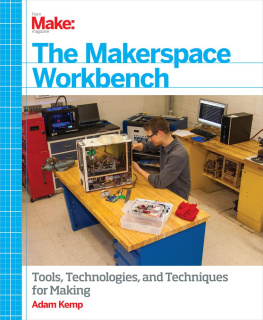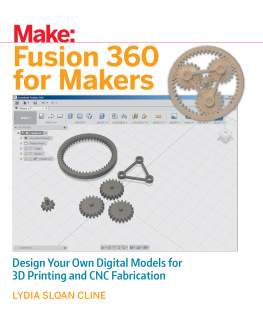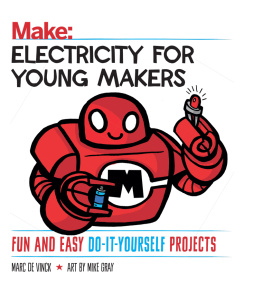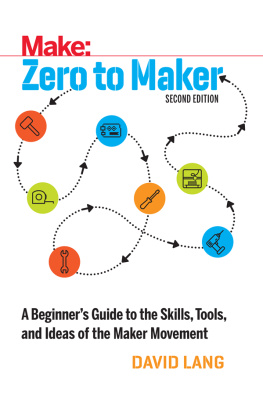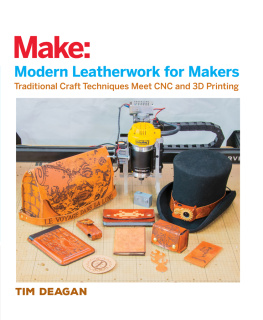The Makers Manual
by Andrea Maietta and Paolo Aliverti
Copyright 2015 Edizioni FAG srl. All rights reserved.
Printed in Canada.
Published by Maker Media, Inc. , 1160 Battery Street East, Suite 125, San Francisco, California 94111.
Maker Media books may be purchased for educational, business, or sales promotional use. Online editions are also available for most titles (.
- Editor: Patrick Di Justo
- Production Editor: Kara Ebrahim
- Copyeditor: Rachel Monaghan
- Proofreader: Charles Roumeliotis
- Translators: David Salvatori and Elisabetta Polcan
- Indexer: Judy McConville
- Interior Designer: David Futato
- Cover Designer: Riley Wilkinson
- Illustrator: Rebecca Demarest
- April 2015: First Edition
Revision History for the First Edition
- 2015-04-03: First Release
See http://oreilly.com/catalog/errata.csp?isbn=9781457185922 for release details.
Make:, Maker Shed, and Maker Faire are registered trademarks of Maker Media, Inc. The Maker Media logo is a trademark of Maker Media, Inc. The Makers Manual and related trade dress are trademarks of Maker Media, Inc.
Many of the designations used by manufacturers and sellers to distinguish their products are claimed as trademarks. Where those designations appear in this book, and Maker Media, Inc. was aware of a trademark claim, the designations have been printed in caps or initial caps.
While the publisher and the authors have used good faith efforts to ensure that the information and instructions contained in this work are accurate, the publisher and the authors disclaim all responsibility for errors or omissions, including without limitation responsibility for damages resulting from the use of or reliance on this work. Use of the information and instructions contained in this work is at your own risk. If any code samples or other technology this work contains or describes is subject to open source licenses or the intellectual property rights of others, it is your responsibility to ensure that your use thereof complies with such licenses and/or rights.
978-1-457-18592-2
[TI]
Preface
A revolution is happening: the manufacture of objects is shifting from big companieswhere your only choice might be the color blackto individuals, producing a previously unseen variety in things we make.
Today, thanks to versatile, powerful, and convenient tools such as Arduino and 3D printers, anyone can easily build, customize, fix, or improve objects. Tools and technologies have changed, but the passion for the process of creation hasnt.
A maker is not necessarily someone who works in design and manufacturing in her day job, but rather someone who always finds a way to turn her passion into an actual source of personal and economic rewards. She may get down to work to solve a personal challenge and then realize there are other people with the same problem. How can these garage inventors turn their passion first into a startup and then into a sustainable business, especially in this period of economic crisis? Even manufacturing and selling are changingthe old criteria do not work anymoreand people who have difficulties with change see their situation worsen day by day.
The new entrepreneurs have an utterly different approach: it is based on scientific techniques that were born within the industry field, reached the software world, and finally arrived in the business system. Just as the open source phenomenon influenced software in the 1990s, today open hardware and open design influence the production of physical objects; new startups create open source products, including both software and hardware. The enterprise philosophy itself is open. It is beneficial to cooperate and collaborate: people share ideas, and the more those ideas spread, the more the people and companies that are part of that community realize the profits. Anyone can contribute to projects and products and even create his own version, exchanging projects, ideas, and techniques to make (almost) anything. Such a model comes from the software world, where a worldwide community of developers works with a spirit of collaboration and sharing. Everyone benefits.
To become a maker there are many things to learn, many of which were familiar to our grandparents, although those skills have largely been forgotten now. A maker, like a modern Leonardo da Vinci, must apply a great variety of skills and knowledge, not only technical expertise.
This manual is an overview of the indispensable tools youll need to become a maker: the starting point for a truly rewarding path.
Born from the actual experience of Frankenstein Garage, which has been active with courses, workshops, and events for makers for years, this book explains complex concepts in a simple and intuitive way, anticipating the questions of those who wish to start or who still havent managed to find their own way. The informal style helps you understand intimidating ideas, and takes you by the hand to help you create your personal toolbox, both physical and mental, in order to make the projects of your dreams a reality.
The manual consists of four parts:
- discusses the makers, explaining the origins of the movement and its potential impact on the economic system.
- proposes an easy yet structured approach to generate or perfect your own ideas (creative techniques, design processes) and make them grow in a favorable environment. It explains what a startup is, how to run a project, what innovation and business models are, how to find reliable collaborators, and how to raise financial resources.
- is the more practical section, and briefly introduces the tools youll need to collaborate. After that, you will learn how to physically create products starting from a model and using technologies such as milling, 3D printing, and laser cutting.
- explains how to give life to your creations, thanks to electronics and microcontrollers. We will also show you how to generate visual interactions, and will give you an overview of the Internet of Things (IoT), the new manufacturing frontier.
Have fun!
Book Site
We have created a website where you can find further information, resources, links, references, and anything else that we couldnt include in the book. You can also download all the sample code listed in the book from this website.
Conventions Used in This Book
The following typographical conventions are used in this book:
ItalicIndicates new terms, URLs, email addresses, filenames, and file extensions.
Constant widthUsed for program listings, as well as within paragraphs to refer to program elements such as variable or function names, databases, data types, environment variables, statements, and keywords.
Constant width boldShows commands or other text that should be typed literally by the user.
Constant width italicShows text that should be replaced with user-supplied values or by values determined by context.
This element signifies a tip, suggestion, or general note.
This element indicates a warning or caution.
Using Code Examples
This book is here to help you get your job done. In general, you may use the code in this book in your programs and documentation. You do not need to contact us for permission unless youre reproducing a significant portion of the code. For example, writing a program that uses several chunks of code from this book does not require permission. Selling or distributing a CD-ROM of examples from Make: books does require permission. Answering a question by citing this book and quoting example code does not require permission. Incorporating a significant amount of example code from this book into your products documentation does require permission.

![Aliverti Paolo The Makers manual: [a practical guide to the new industrial revolution]](/uploads/posts/book/177221/thumbs/aliverti-paolo-the-maker-s-manual-a-practical.jpg)

